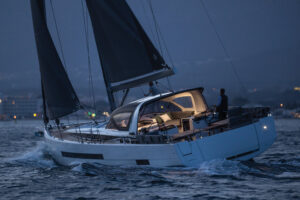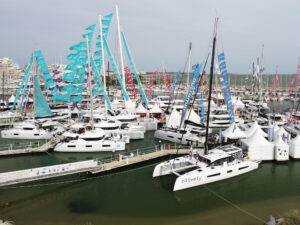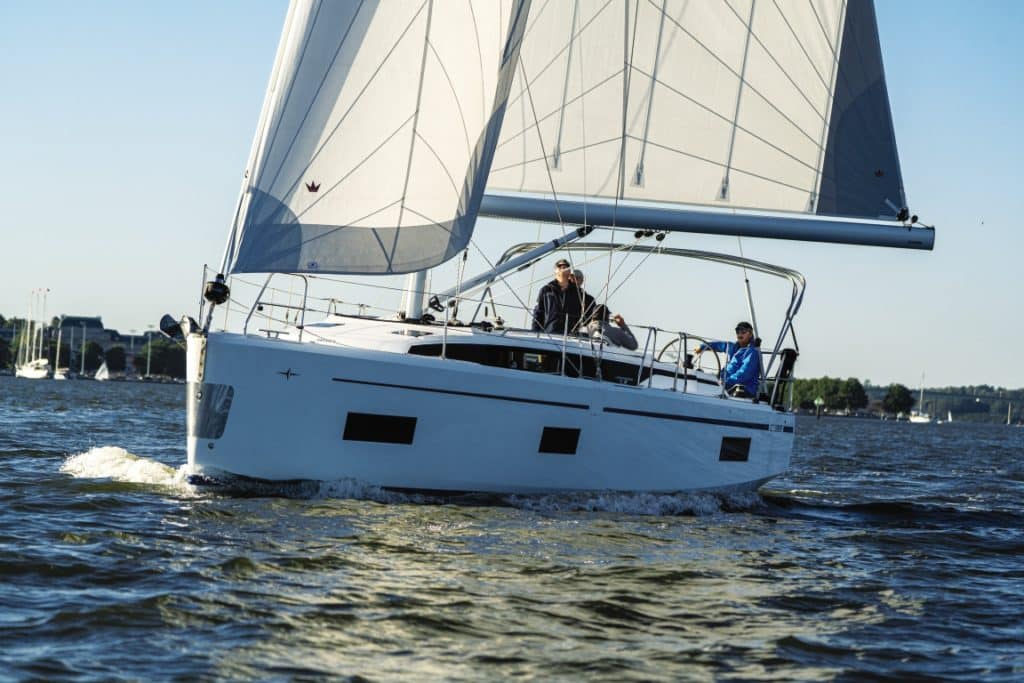
For the past several years, practically all of the design surprises that have caught my eye on new sailboats have been abaft the mast. In no particular order, these innovative features include hull chines, twin rudders, pop-up TVs, house-style refrigerators, galleys forward in the saloon, sinks and grills on the stern, sun beds between a monohull’s twin wheels, and lounges on the coachroof to either side of the companionway. Some of these make the boat sail better, while others make it a more comfortable place to enjoy life on the water.
But this past fall, it was the pointy end—or, should I say, the not-so-pointy end—of the Bavaria C38 that stood out. It made an impression from above, as I looked across the broad foredeck, and down below, where the builder’s in-house team and Cossutti Yacht Design somehow found a way to install a king-size berth in the owner’s stateroom, while still leaving room for a hanging locker and a head-and-shower compartment, all forward of the mast.
For a decade or more, even as beam measurement amidships has steadily increased and been carried aft to allow for ever more spacious twin staterooms, most boats still have been built with a bow that’s shaped like an arrow point. The Bavaria V-bow, as the company calls it, has a more radial shape and hullsides that flare out above the waterline, creating all that living space in the interior.
In a briefing with CW’s Boat of the Year judges, a company representative described the 38 as a family coastal cruiser. I thought that design brief seemed pretty accurate as we went through the boat, and later took it out for a sail. If kids and their friends are the crew, you could pack a pile of them into the two aft cabins, and the dining table in the saloon drops down to form a third double berth. And they could all share the head and shower compartment to starboard, at the foot of the companionway. Meantime, mom and pop can escape to the big forward stateroom.
The forward stateroom’s en suite head compartment does cut into a corner of the berth, but couples who plan to only occasionally have grandkids or friends aboard can forgo the forward head. They also could turn one of the aft cabins into a workspace or stowage, which is standard.
In all three configurations, the saloon stays unchanged. A settee, with a nav desk forward of it, is to port, opposite the dining table and a U-shaped, cushioned seat. The tabletop folds open to handle a crew of six or more. Abaft the settee is an L-shaped galley with a sink, fridge and three-burner gas stove. The boat we visited also had a microwave. Stowage seemed adequate for coastal-hopping, and the counters had fiddles to keep things from sliding off when heeled.
Topsides, the cockpit coamings make good backrests on the benches forward of the twin wheels. The seats are a bit too short for sleeping, the judges noted, but stepping out over the coamings isn’t difficult when headed forward.
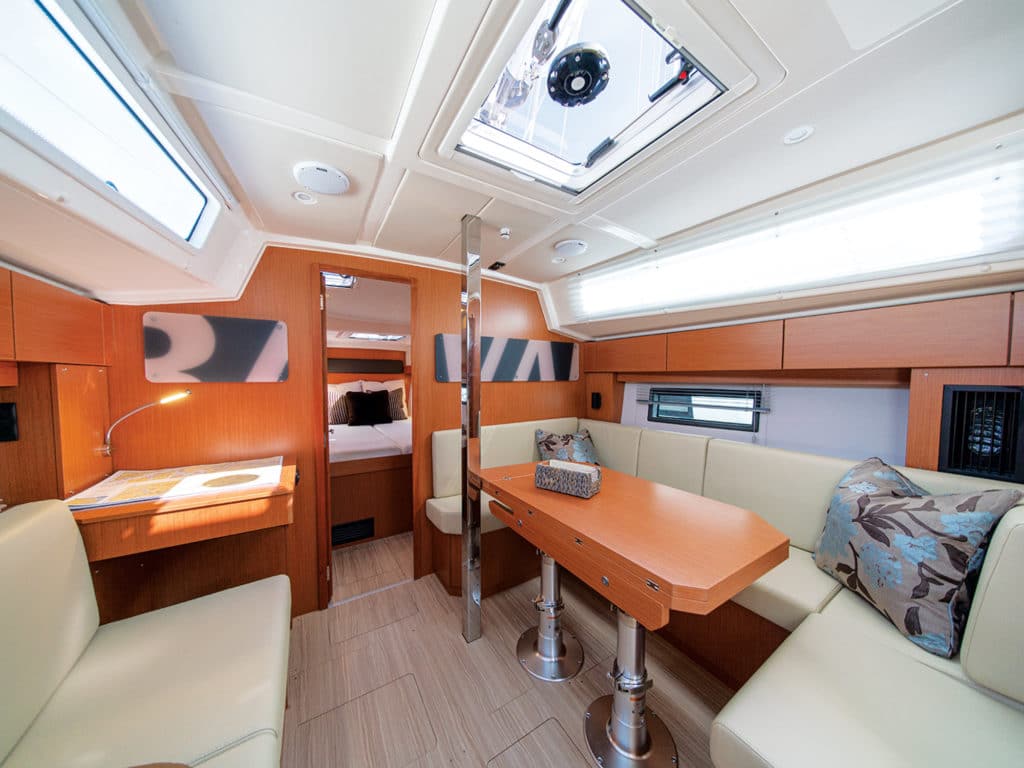
Having owned (and sanded and varnished) a boat with exterior wood handrails and trim, I appreciated the C38’s low-maintenance exterior finish. The raised bulwarks and deck are fiberglass, and handrails on the cabin top are stainless steel. The only exterior wood is on the centerline table in the cockpit. That table’s after end doubles as a nifty place to mount a plotter because it’s visible from either helm. Far forward, there’s a chain locker with good access to the windlass and anchor rode. The anchor itself is stowed on a roller that extends forward, and the bow is further protected from accidental dings by a stainless-steel plate. Aft, there is equally good access to the emergency steering and quadrant for the single rudder.
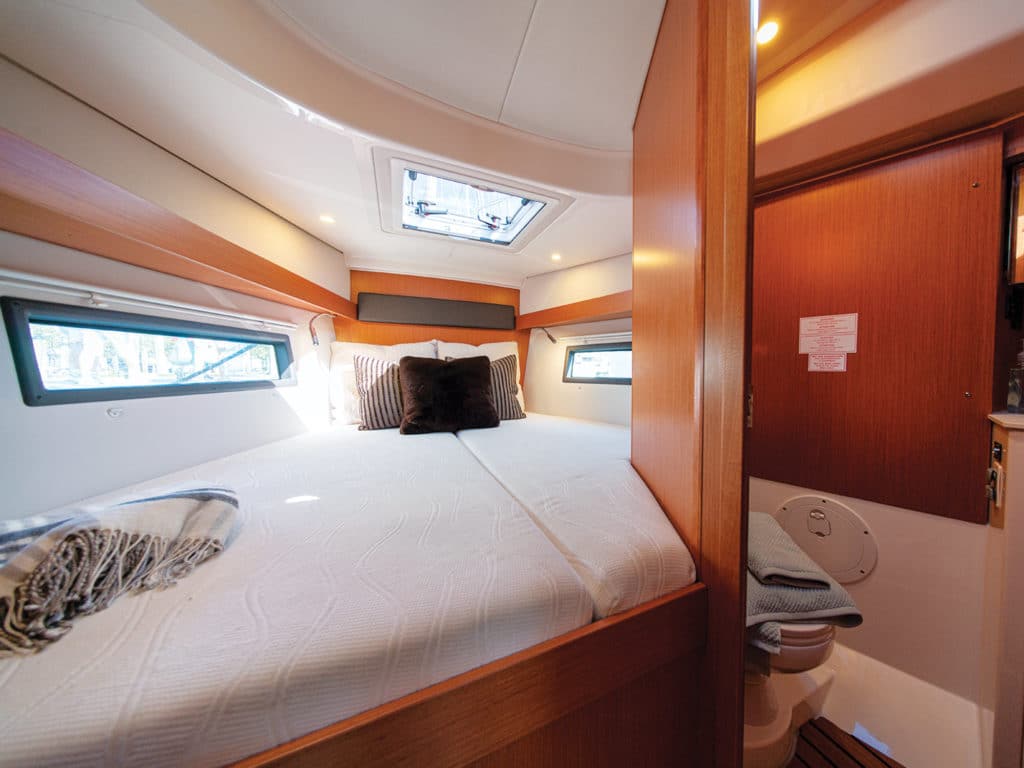
A base-model C38 has a price tag of $248,000, but a model that’s well fitted out, like the one we visited, goes for $350,000, delivered to the United States, East Coast. Among the options included on the C38 we sailed were three air-conditioning units, a Fusion sound system, and synthetic teak called Esthec on the cockpit seats and sole, and the swim platform. Hardware and electronics were from Seldén, Lewmar and B&G. Sails were from Elvstrøm.
Bavaria builds 500-plus sailboats a year at its factory in Germany, and the C38 is the smallest in the five-boat Cossutti-designed C line; the flagship is a 57-footer. The company builds two other lines of cruising sailboats—the Cruiser and Vision ranges—for a total of 16 models starting at 32 feet.
Bavaria’s hulls and decks are all hand-laminated, with foam coring between inner and outer layers of fiberglass. Aluminum plates are in the composite sandwich wherever hardwaare is to be mounted. Hulls and decks are joined with adhesive and screws.
Underway, the C38 is a relatively simple boat to sail, with in-mast furling for the main and a self-tacking jib, also set on a furler. The boat doesn’t have a traveler, so when beating upwind, tacking requires just a turn of the wheel.
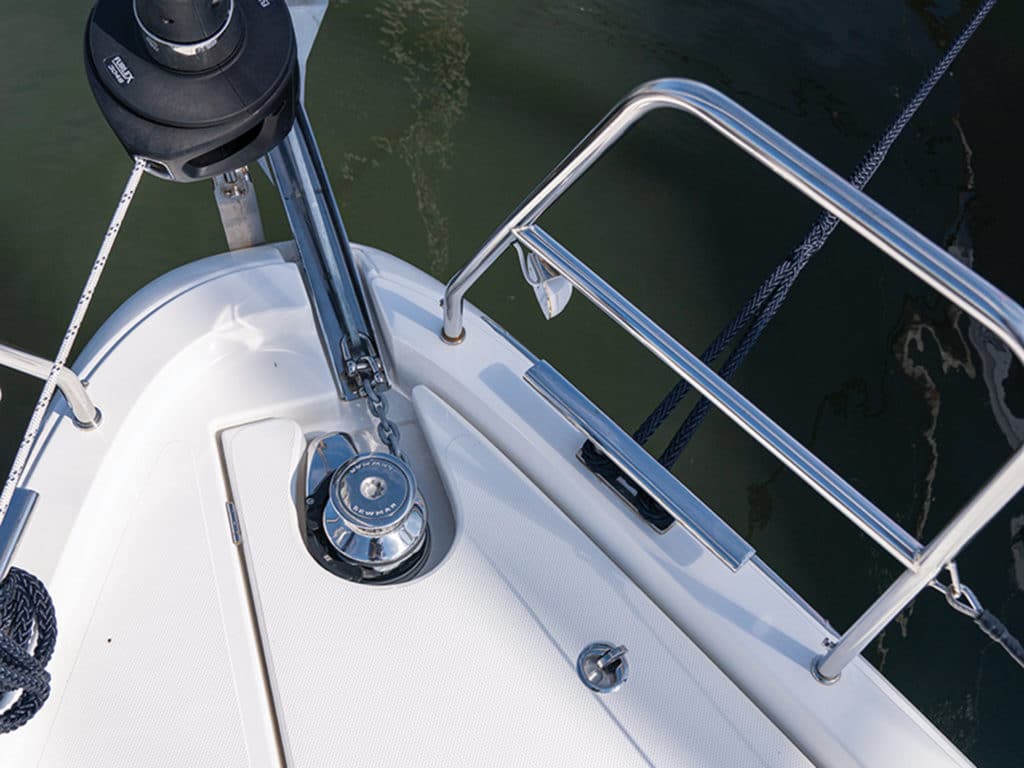
A double-ended mainsheet is led back to winches within reach of either of the twin wheels, and sail control lines are all led across the coachroof to clutches and a pair of winches on either side of the companionway. There are also genoa tracks mounted on deck and sheet winches on either coaming, should an owner opt for an overlapping genoa.
Underway, I found that visibility from either wheel was good, thanks to the low-profile cabin. The stainless-steel stern pulpit makes a good backrest when sitting down to steer.
We had moderate conditions the day we took the boat out for a sail on the Chesapeake Bay, right after the close of the United States Sailboat Show in Annapolis, Maryland, in October. Sailing hard on the wind in 15 or so knots of breeze, we saw a steady 5.5 knots on the GPS. The track for the self-tending jib’s car lacked stops, so we weren’t able to get the headsail in as far as we might have liked to, but that’s an easy fix. With the sheets eased a bit for a close reach, our speed jumped to 7 knots and change. Under power, the 40 hp Yanmar pushed us along at just over 6 knots, at a fuel-sipping 2,300 rpm cruising speed.
The skipper who delivered the boat to the show was along for the ride. He said that they’d encountered a variety of conditions on the ride up from St. Augustine, Florida, and the boat took them all in stride—just as a family cruiser should.
Bavaria C38 Specifications
| LENGTH OVERALL | 37’4″ (11.38 m) |
|---|---|
| WATERLINE LENGTH | 33’9″ (10.29 m) |
| BEAM | 13’1″ (3.99 m) |
| DRAFT | 5’5″ (1.65 m) |
| SAIL AREA (100%) | 768 sq. ft. (71.3 sq. m) |
| BALLAST | 5,423 lb. (2,460 kg) |
| DISPLACEMENT | 20,547 lb. (9,320 kg) |
| BALLAST/DISPLACEMENT | 0.26 |
| DISPLACEMENT/LENGTH | 239 |
| SAIL AREA/DISPLACEMENT | 16.4 |
| WATER | 132 gal. (500 L) |
| FUEL | 46 gal. (174 L) |
| HOLDING | 18 gal. (70 L) |
| MAST HEIGHT | 60’11” (18.57 m) |
| ENGINE | 40 hp Yanmar, saildrive |
| DESIGNER | Cossutti Yacht Design |
| PRICE | $248,000 |
| Bavaria Yachts | 49-9334-9420 |
Sea Trial
| WIND SPEED | 15-17 knots |
|---|---|
| SEA STATE | Light chop |
| SAILING | Closehauled 5.4 |
| Reaching 7.0 | |
| MOTORING | Cruise (2,300 rpm) 6.1 knots |
| Fast (2,800 rpm) 7.0 knots |

